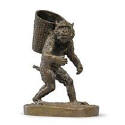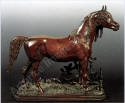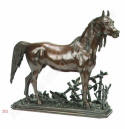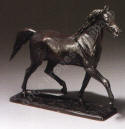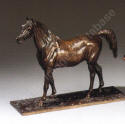
Zaidan Gallery
Since 1974
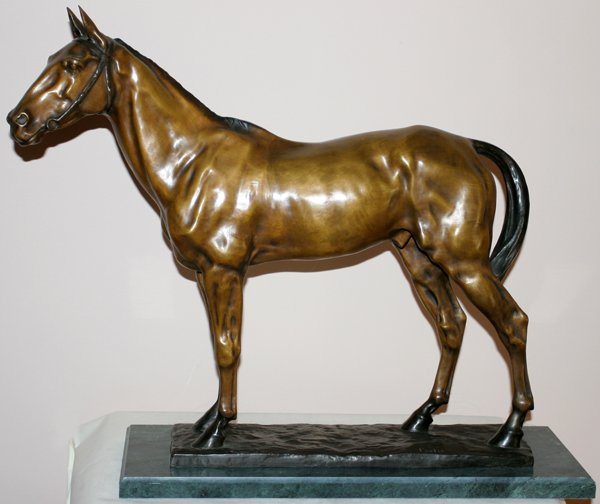 |
|
|
AFTER CHRISTOPHE FRATIN BRONZE SCULPTURE OF A STALLION signed on base, mounted on a green marble plinth. H 24", L 28", Signed.
Sales Price $3,900 or best offer
|
Signature |
|
Christophe Fratin, was a noted French sculptor in the animalier style, and one of the earliest French sculptors to portray animals in bronze. His sculpturs are on permanent display in the Louvre; the city museums of Lyon, Metz, and Nîmes; the Wallace Collection in London; the Peabody Institute in Baltimore, Maryland; and the Georg Eisler archive in Vienna. The son of a shoe-maker and sometime taxidermist in Metz on the eastern edge of France and he came onto the Paris scene at the landmark Salon of 1831, the exhibition that launched the Romantic movement with groundbreaking compositions by Delacroix and Delaroche as well as major works by the landscape artists who would form the heart of the century's Realist movement. Together with the slightly older sculptor Antoine Barye (who showed his first animal models at the same Salon), Fratin quickly established the important place of animalier sculpture at the heart of the naturalistic revolution that so effectively undermined the conservative French art establishment. Initially, Fratin's role was as a junior artist to Barye, supplying secondary animal figures for the elaborate surtout du table commissioned by the Duc d'Orléans during the mid-1830s to feature several of Barye's hunting scenes. But with Fratin's 1839 Salon bronze of An Eagle and Vulture Disputing their Prey, he established himself as a formidable rival to Barye and as an indisputable master of the subject matter of animals in combat. Throughout the next decade, Fratin's monumental animal groups and single figures of elegant horses or powerful dogs were sought after by more liberal members of the French aristocracy as well as by collectors all over Europe. Finally, with the establishment of a more liberal government in France under the Second Empire in 1851, Fratin began to receive official state commissions for his larger groups. Alexandra Murphy Fratin learned animal anatomy by assisting in his father's taxidermy practice and studied art under the important French Romantic painter Theodore Gericault. Fratin's sculptures, which typically portrayed animals thin and gaunt as they would appear in the wild, reflected a life-like realism that was shunned by many of his fellow animalier artists who favored modeling their sculptures after well-fed zoo animals. Fratin was a contemporary of the renowned French animalier sculptor Antoine-Louis Barye, and the two artists shared a similar struggle with the French Academy for acceptance of their work. wildlifeart |
|
|
References:
|
|
|
Zaidan International, 7881 Decarie Blvd. Suite 405, Montreal, Quebec, H4P2H2 Canada Phone: 1(514)944-7027, Fax:1(514)944-7027, email: info@zaidan.ca This site contains links to other Internet sites. These links are not endorsements of any products or services in such sites, and no information in such site has been endorsed or approved by Zaidan International. |
|

